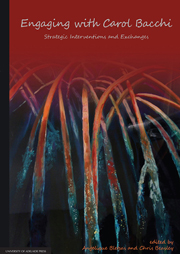Book contents
- Frontmatter
- Contents
- Acknowledgements
- List of Contributors
- Introduction
- Part I Looking back: On beginning
- 1 From women's history to women's policy: Pathways and partnerships
- Part II Strategic interventions and exchanges: Reflections and applications of the ‘What's the Problem Represented to be?’ approach
- Part III Strategic exchanges: The wider context
- Part IV Looking forward: Still engaged
1 - From women's history to women's policy: Pathways and partnerships
from Part I - Looking back: On beginning
Published online by Cambridge University Press: 05 June 2013
- Frontmatter
- Contents
- Acknowledgements
- List of Contributors
- Introduction
- Part I Looking back: On beginning
- 1 From women's history to women's policy: Pathways and partnerships
- Part II Strategic interventions and exchanges: Reflections and applications of the ‘What's the Problem Represented to be?’ approach
- Part III Strategic exchanges: The wider context
- Part IV Looking forward: Still engaged
Summary
A personal reflection
My links with Carol Bacchi go back a long way, probably much further back than either of us cares to admit. Carol started teaching at The University of Adelaide in the History Department in 1978 as a tutor in Australian history. I was teaching in what was then the Education Department as a tutor in the history of education. Perhaps I need to explain here exactly what a tutor was, as it is a species that is now virtually extinct in Australia. Tutors, mainly women, took tutorial classes—usually six to eight a week—attended lectures and undertook vast stacks of marking. They were also meant to complete their higher degrees if they had not done so already, and to engage in research. There was no guarantee that a tutoring job would lead to anything else but somehow Carol and I managed to move on to academic posts. As a mother of three young children at the time, I thought tutoring was a dream job and I fervently hoped to keep it for life. But that was before the women's movement fired up my ambition. I am sure neither of us would have thought in our wildest dreams that we would become professors—generally women did not.
- Type
- Chapter
- Information
- Engaging with Carol BacchiStrategic Interventions and Exchanges, pp. 9 - 18Publisher: The University of Adelaide PressPrint publication year: 2012



